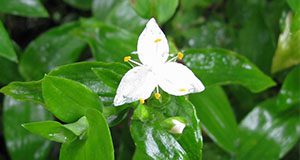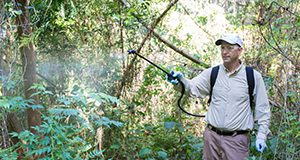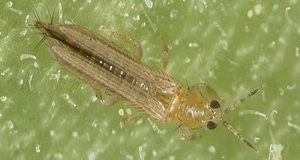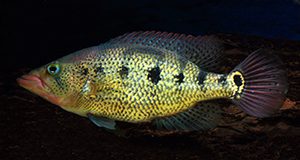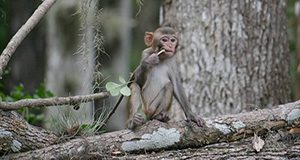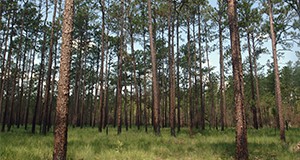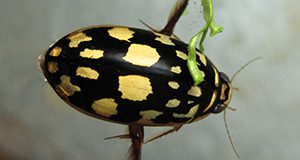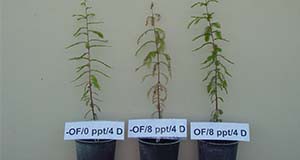Southern tick-associated rash illness (STARI) is a human tick-borne disease that occurs following the bite of Amblyomma americanum, the lone star tick, which is the most common and aggressive human-biting tick in the South, accounting for over 90% of human tick bites in the region. STARI is often described as a “Lyme-like illness” because it causes a rash like the “bulls eye” rash associated with Lyme. Other symptoms of STARI that are similar to symptoms of Lyme disease include headache, fatigue, and muscle and joint pain. Scientists know the tick vector and that some wildlife species play a role in maintaining the disease in nature, but very little else is understood about this mysterious illness. This 4-page fact sheet written by Katherine Sayler, Carisa Boyce, and Samantha Wisely and published by the Department of Wildlife Ecology and Conservation provides the basic facts we do know, the differences between STARI and Lyme disease, plus advice for tick-bite sufferers and strategies to avoid tick bites.
http://edis.ifas.ufl.edu/uw421
Category: Ecosystems & Species
New Featured Creatures, August 2016
- Melaleuca Gall Midge (suggested common name) Lophodiplosis trifida Gagné (Insecta: Diptera: Cecidomyiidae: Cecidomyiinae: Cecidomyiini)
http://edis.ifas.ufl.edu/in1140
Pest Identification Guides, August 2016
Created to help growers and crop consultants, private homeowners, Master Gardeners, and the general public identify common arthropod pests and the damage they inflict, each field guide provides photos of the important life stages and crop damage associated with arthropod pests. The text highlights key general morphology and biology, distribution, and natural enemies. Written by Jeffrey Cluever and Hugh Smith, and published by the UF Department of Entomology and Nematology.
The following have been added to the existing series, http://edis.ifas.ufl.edu/topic_series_pest_identification_guides
How to Use a Dichotomous Key: A Tutorial Featuring 10 Common Shade Trees of the Tampa Bay Area
A dichotomous key is a tool used to help identify an unknown organism. This twelve-page fact sheet features a key of leaf characteristics for ten common broadleaf trees in the Tampa Bay Area. Accurately navigating this series of paired, either-or choices about leaf characteristics will lead the reader to identify the correct tree from the group of ten. Written by Andrew K. Koeser, Gitta Hasing, Michael G. Andreu, and Melissa H. Friedman and published by the Environmental Horticulture Department.
http://edis.ifas.ufl.edu/ep510
10 Common Palms of the Tampa Bay Area
Palms often serve as key specimens in urban landscape designs. Despite this, their identity is often unknown to Florida’s new, seasonal, and even long-term residents. This ten-page fact sheet serves as a quick reference for some of the most common palms found in North and Central Florida and the Tampa Bay Area in particular. Written by Gitta Hasing, Andrew K. Koeser, Melissa H. Friedman, and Timothy K. Broschat and published by the Environmental Horticulture Department.
http://edis.ifas.ufl.edu/ep506
Identification, Biology, and Control of Small-Leaf Spiderwort (Tradescantia fluminensis): An Invasive Weed of Virtually Worldwide Distribution
Tradescantia fluminensis (small-leaf spiderwort) is a perennial subsucculent herb native to tropical and subtropical regions of Brazil and Argentina. The species has been introduced to the United States and countries in many parts of the world where it is often considered invasive. This seven-page fact sheet describes the small-leaf spiderwort, its taxonomy, geographical distribution, biology and ecology, reproduction and colonization, its impact as a weed in the southeastern United States, and ways of managing the spread of small-leaf spiderwort. Written by Jason C. Setiz and Mark W. Clark and published by the Department of Soil and Water Science.
http://edis.ifas.ufl.edu/ss652
Herbicides to Kill Invasive Trees in Home Landscapes and Surrounding Natural Areas
Several plant species that are invasive in natural areas of public lands also occur on private property. Invasive plants on private property that thrive within both landscaped and surrounding natural areas can serve as a source of infestation to other natural areas. Therefore, property owners are encouraged to remove invasive plant species from both areas. This 5-page fact sheet is a major revision that discusses different herbicides, hand-pulling, stump grinding, foliar herbicide application, cut stump herbicide application, basal bark herbicide application, hack-and-squirt, frill, or girdle herbicide application, licenses and training, and control of specific invasive plants. Written by K. A. Langeland and S. F. Enloe, and published by the UF Department of Agronomy, revised May 2016.
http://edis.ifas.ufl.edu/ag259
New Featured Creatures: July 2016
- Emerald Ash Borer Agrilus planipennis Fairmaire (Insecta: Coleoptera: Buprestidae)
http://edis.ifas.ufl.edu/in1141 - Hercules Beetle Dynastes Hercules (Linnaeus, 1758) (Insecta: Coleoptera: Scarabaeidae)
http://edis.ifas.ufl.edu/in1142
New Featured Creatures: June 2016
- Bluegrass Billbug Sphenophorus parvulus Gyllenhal (Insecta: Coleoptera: Curculionidae: Dryophthorinae)
http://edis.ifas.ufl.edu/in1133 - Rustic Sphinx Manduca rustica (Fabricius) (Insecta: Lepidoptera: Sphingidae)
http://edis.ifas.ufl.edu/in1134
Pest Identification Guide: Western Flower Thrips Frankliniella occidentalis (Pergande)
Western flower thrips transmits the carmovirus Pelargonium flower break virus (PFBV), the ilarvirus Tobacco streak virus (TSV), and the tospoviruses Chrysanthemum stem necrosis virus (CSNV), Groundnut ringspot virus (GRSV), Impatiens necrotic spot virus (INSV), Tomato chlorotic spot virus (TCSV), and Tomato spotted wilt virus (TSWV). This species is primarily a flower feeder, so most damage would be expected on the flower or fruit. Learn to identify the western flower thrips with this two-page illustrated guide written by Jeffrey D. Cluever and Hugh A. Smith and published by the Department of Entomology and Nematology.
http://edis.ifas.ufl.edu/in1127
Freshwater Fish of New River, Belize
Belize is home to an abundant diversity of freshwater fish species and is often considered a fishing paradise. The New River area is a popular freshwater fishing destination in the Orange Walk district of northern Belize. Here locals and visitors alike take to the lagoons and waterways for dinner or for good sportfishing. This 3-page guide written by Venetia Briggs-Gonzalez, Kyle Allen, and Frank J. Mazzotti and published by the Wildlife Ecology and Conservation Department highlights the most popular species in the area and will help people identify and understand these species.
http://edis.ifas.ufl.edu/uw406
Cressleaf Groundsel (Butterweed) Identification and Management in Pastures
 Butterweed is a winter annual that is toxic to both cattle and horses. This 2-page fact sheet provides an overview of the plant as well as herbicide recommendations. Written by Brent Sellers and Jay Ferrell, and published by the UF Agronomy Department, May 2016.
Butterweed is a winter annual that is toxic to both cattle and horses. This 2-page fact sheet provides an overview of the plant as well as herbicide recommendations. Written by Brent Sellers and Jay Ferrell, and published by the UF Agronomy Department, May 2016.
http://edis.ifas.ufl.edu/ag406
History and Status of Introduced Rhesus Macaques (Macaca mulatta) in Silver Springs State Park, Florida
Local folklore suggests that the rhesus macaque monkeys living in what is today Silver Springs State Park were released while the 1939 movie Tarzan "Finds a Son" was filmed at the site, but no rhesus macaques appear in that movie, and the macaques had been living in Silver Springs for a considerable time before Tarzan found his son there. In fact, today’s thriving population of macaques in Silver Springs State Park descended from monkeys intentionally released earlier in the 1930s in an effort to increase tourism to the area.
Silver Springs became a tourist attraction in the 1870s and has had glass-bottom boat tours ever since. In the 1930s the manager of the glass bottom boat operation, Colonel Tooey, released approximately six rhesus macaques to attract tourists and increase revenue for the boat tours. Not knowing rhesus macaques are proficient swimmers, Colonel Tooey released his monkeys on an island in the Silver River from whence they quickly swam to the surrounding forests, where they made themselves at home and set up a growing colony. What happened next? Learn the story (so far!) of the monkeys and the park in this 4-page fact sheet written by C. J. Anderson, S. A. Johnson, M. E. Hostetler, and M. G. Summers and published by the Department of Wildlife Ecology and Conservation.
edis.ifas.ufl.edu/uw412
Landowner Cost-Share Incentives and Payments for Ecosystem Services: A Comparison of Key Program Features
Landowners who conduct land management activities that protect environmental benefits may be eligible for several types of financial assistance from the government, but not all incentive strategies are the same. This 4-page fact sheet written by Melissa M. Kreye, Elizabeth Pienaar, and Raoul K. Boughton and published by the Department of Wildlife Ecology and Conservation compares traditional cost-share programs offered to landowners through federal agencies and a new type of market-based incentive program called payments for ecosystem services (PES). The information inside can help private landowners understand the advantages and limitations of both approaches and guide decision-makers in designing effective future conservation incentive programs.
edis.ifas.ufl.edu/uw415
Using the Ecosystem Services Approach to Advance Conservation Efforts on Private Lands
Decision-makers in Florida have shown increased interest in using the Ecosystem Services (ES) approach to reward ecosystem conservation efforts on private lands. For example, payments for ecosystem services (PES) strategies have been effective in motivating landowners to conserve ecosystems on their land. Some landowners may find a better understanding of the ES approach to be useful when deciding to participate in a PES program. This 5-page fact sheet written by Melissa M. Kreye, Elizabeth Pienaar, Raoul K. Boughton, and Lindsey Wiggins and published by Department of Wildlife Ecology and Conservation will provide landowners, Extension agents, government and agency leaders, and other stakeholders with a better understanding of how ES are classified, the different ways ES can be valued, how quantifying ES values can help support conservation efforts on private lands in Florida, and a few of the challenges inherent in using the ES approach.
edis.ifas.ufl.edu/uw414
Predaceous Diving Beetles as Pets and the Self-Cleaning Aquarium
Meet a new, attractive, easy-to-keep, local, non-endangered, aquatic pet: the diving beetle! Predaceous diving beetles are aesthetically pleasing yet still rare in US aquariums (though common in countries like Japan), which makes them a fun, new, unusual pet. This 5-page fact sheet written by Craig Bateman and Jiri Hulcr and published by the School of Forest Resources and Conservation provides information about the aquatic beetles, including how to catch and maintain them. Learn how you can befriend these sprightly little insect pals and allow them to bring to your home a mysterious green and quiet world, beautiful silver air bubbles and bronze iridescence, and exciting shows of feeding frenzy. And if you have to part with them, you can safely release the native species into the wild, because they are a part of our Florida natural landscape.
edis.ifas.ufl.edu/fr398
Zika Vector Control for the Urban Pest Management Industry
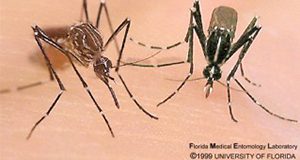
Zika is a mosquito-transmitted virus that has recently spread to the Americas. Zika virus (ZIKV) was discovered in 1946 in Africa where it was isolated from a Rhesus monkey in the Zika forest of Uganda. In 2007, a disease outbreak occurred on the Yap islands in Micronesia, and in 2013, an outbreak occurred in French Polynesia. In 2015, a large outbreak occurred in Brazil, and ZIKV has since spread through the Americas. As of April 18, 2016, 15 counties in the state of Florida had reported travel-associated Zika cases. This seven-page fact sheet provides an overview of ZIKV, including its incidence and distribution, transmission and symptoms, and the connection between zika virus and infant microcephaly. This article also explains the biology and identification of the mosquito that vectors the virus with a focus on how to manage the vector using inspection, larviciding, adulticiding, monitoring, and personal protective equipment. Written by Casey Parker, Roxanne Connelly, Dale Dubberly, Roberto Pereira, and Philip Koehler and published by the Entomology and Nematology Department.
http://edis.ifas.ufl.edu/in1131
Pond Apple: A Tree Species Adapted to Salt Stresses

Soil salinity is a naturally ocurring problem for growers, gardeners, and homeowners in Florida. As sea-levels rise, seawater intrusion causes salt stress to plants grown in coastal lowland areas. This three-page fact sheet introduces a salt-tolerant species, pond apple (Annona glabra L.), which has great potential to be used in high-salinity coastal landscapes. Written by Guodong Liu, Yuncong Li, Kimberly Moore, and Kim Gabel and published by the Horticultural Sciences Department.
http://edis.ifas.ufl.edu/hs1281
Temporary Food Plot Deterrents for Deer: Do They Work?
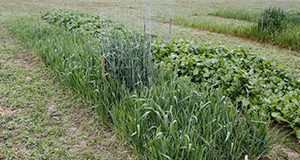
Many Floridians enjoy the opportunity to hunt, watch, or photograph white-tailed deer. Hunters and landowners often plant cool season forage plots both to attract wildlife and to provide a dependable food source. But where there is a high deer population or scarce food resources, deer may forage on food plots as soon as the plants emerge and before they become established. This fact sheet presents the results of research conducted at the UF/IFAS North Florida Research and Education Center in Quincy into the effectiveness of various strategies hunters and landowners can use to temporarily limit access to new food plots until the plants are well established and strong enough to attract and sustain hungry deer through the winter. Written by Holly Ober, Cheryl Mackowiak, and Ann Blount and published by the UF/IFAS Department of Wildlife Ecology and Conservation.
http://edis.ifas.ufl.edu/uw410
How to Chemigate Salinity-Stressed Plants with Hydrogen Peroxide to Increase Survival and Growth Rates
Man-made activities can induce climate change and global sea-level rise, posing threats to the survival and growth of coastal vegetation in Florida. This three-page fact sheet explains how to ensure plant survival and facilitate the growth of coastal vegetation threatened by sea-level rise and the resulting oxygen deficiencies and saline stresses. Written by Guodong Liu, Yuncong Li, Kimberly Moore, Kim Gabel, Lei Wu, and Rafael Muñoz-Carpena, and published by the Horticultural Sciences Department.
http://edis.ifas.ufl.edu/hs1280



